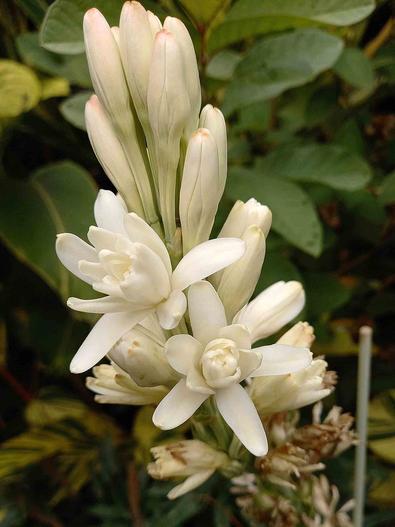Tuberose
(Agave amica)
Tuberose (Agave amica)
/
/

阿橋花譜 HQ Flower Guide
CC BY-SA 2.0
Image By:
阿橋花譜 HQ Flower Guide
Recorded By:
Copyright:
CC BY-SA 2.0
Copyright Notice:
Photo by: 阿橋花譜 HQ Flower Guide | License Type: CC BY-SA 2.0 | License URL: https://creativecommons.org/licenses/by-sa/2.0/ | Uploader: 阿橋 KHQ | Publisher: Flickr




Estimated Native Range
Summary
Agave amica, commonly known as Tuberose, is a perennial herb native to Mexico, where it thrives in open woodlands and grassy fields. It is characterized by its tuberous roots and can reach a height and width of 2-3 feet. The Tuberose is renowned for its intensely fragrant, waxy white flowers that bloom in the summer and fall, making it highly valued in the perfume industry. The flowers are borne on erect spikes and are especially showy at night when they release their scent.
Tuberose is celebrated for its enchanting fragrance and is often used in bouquets and as a cut flower, particularly the ’Mexican Single’ variety which has a longer vase life. ’The Pearl’, a double-flowered cultivar, is admired for its ornamental pale pink buds that open to cream-colored blooms. Tuberose requires a warm climate to flower and is typically started in pots under greenhouse conditions before being transplanted outdoors. It prefers full sun exposure and does well in soils with slow to medium drainage. After the blooming period and once the foliage yellows, the tubers should be dug up and stored for the winter. While generally easy to maintain, tuberose can be susceptible to root rot if overwatered or planted in poorly drained soils.CC BY-SA 4.0
Tuberose is celebrated for its enchanting fragrance and is often used in bouquets and as a cut flower, particularly the ’Mexican Single’ variety which has a longer vase life. ’The Pearl’, a double-flowered cultivar, is admired for its ornamental pale pink buds that open to cream-colored blooms. Tuberose requires a warm climate to flower and is typically started in pots under greenhouse conditions before being transplanted outdoors. It prefers full sun exposure and does well in soils with slow to medium drainage. After the blooming period and once the foliage yellows, the tubers should be dug up and stored for the winter. While generally easy to maintain, tuberose can be susceptible to root rot if overwatered or planted in poorly drained soils.CC BY-SA 4.0
Plant Description
- Plant Type: Succulent
- Height: 2-3 feet
- Width: 2-2.5 feet
- Growth Rate: Moderate
- Flower Color: White
- Flowering Season: Summer, Fall
- Leaf Retention: Evergreen
Growth Requirements
- Sun: Full Sun
- Water: Medium
- Drainage: Slow, Medium
Common Uses
Bee Garden, Bird Garden, Deer Resistant, Drought Tolerant, Fire Resistant, Fragrant, Groundcover, Hummingbird Garden, Potted Plant, Rabbit Resistant, Rock Garden, Street Planting
Natural Habitat
Native to open woodlands and grassy fields in Mexico
Other Names
Common Names: Tuberose
Scientific Names: , Polianthes tuberosa, Agave amica, Agave polianthes, Polianthes tuberosa f. plena, Polianthes gracilis, Crinum angustifolium, Polianthes tuberosa subsp. gracilis, Polianthes tuberosa subsp. plena, Polianthes tuberosa var. gracilis
GBIF Accepted Name: Agave polianthes Thiede & Eggli